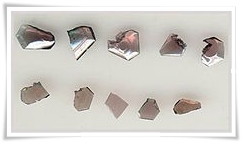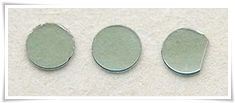Silicon Carbide
Since we are in the Silicon Business over 20 years now we can procide all sorts and specifications of Silicon material. High pure Polysilicon as well as Silicon Metal and also Silicon Carbide.
Silicon carbide (SiC), also known as carborundum /kɑrbəˈrʌndəm/, is a compoundof siliconand carbonwith chemical formula SiC. It occurs in nature as the extremely rare mineral moissanite. Silicon carbide powder has been mass-produced since 1893 for use as an abrasive. Grains of silicon carbide can be bonded together by sinteringto form very hard ceramicswhich are widely used in applications requiring high endurance, such as car brakes, car clutches and ceramic platesin bulletproof vests. Electronic applications of silicon carbide as light emitting diodes(LEDs) and detectorsin early radios were first demonstrated around 1907, and today SiC is widely used in high-temperature/high-voltage semiconductor electronics. Large single crystals of silicon carbide can be grown by the Lely method; they can be cut into gems known as synthetic moissanite. Silicon carbide with high surface area can be produced from SiO2 contained in plant material.
Natural occurrence
Moissanite single crystal (≈1 mm in size) Naturally occurring moissaniteis found in only minute quantities in  certain types of meteoriteand in corundum deposits and kimberlite. Virtually all the silicon carbide sold in the world, including moissanite jewels, is synthetic. Natural moissanite was first found in 1893 as a small component of the Canyon Diablo meteoritein Arizonaby Dr. Ferdinand Henri Moissan, after whom the material was named in 1905. Moissan's discovery of naturally occurring SiC was initially disputed because his sample may have been contaminated by silicon carbide saw bladesthat were already on the market at that time.
certain types of meteoriteand in corundum deposits and kimberlite. Virtually all the silicon carbide sold in the world, including moissanite jewels, is synthetic. Natural moissanite was first found in 1893 as a small component of the Canyon Diablo meteoritein Arizonaby Dr. Ferdinand Henri Moissan, after whom the material was named in 1905. Moissan's discovery of naturally occurring SiC was initially disputed because his sample may have been contaminated by silicon carbide saw bladesthat were already on the market at that time.
While rare on Earth, silicon carbide is remarkably common in space. It is a common form of stardustfound around carbon-rich stars, and examples of this stardust have been found in pristine condition in primitive (unaltered) meteorites. The silicon carbide found in space and in meteorites is almost exclusively the beta-polymorph. Analysis of SiC grains found in the Murchison meteorite, a carbonaceous chondritemeteorite, has revealed anomalous isotopic ratios of carbon and silicon, indicating an origin from outside the solar system; 99% of these SiC grains originate around carbon-rich asymptotic giant branchstars. SiC is commonly found around these stars as deduced from their infrared spectra.
Production
Because of the rarity of natural moissanite, most silicon carbide is synthetic. It is used as an abrasive, and more recently as a semiconductorand diamond simulantof gem quality. The simplest manufacturing process is to combine silicasandand carbon in an Acheson graphite electric resistance furnaceat a high temperature, between 1600 and 2500 °C. Fine SiO particles in plant material (e.g. rice husks) can be converted to SiC by heating in the excess carbon from the organic material. The silica fume, which is a byproduct of producing silicon metal and ferrosilicon alloys, also can be converted to SiC by heating with graphite at 1500 °C.
|
|
| Synthetic SiC crystals ~3 mm in diameter |
 |
| Synthetic SiC Lely crystals |
The material formed in the Acheson furnace varies in purity, according to its distance from the graphiteresistorheat source. Colorless, pale yellow and green crystals have the highest purity and are found closest to the resistor. The color changes to blue and black at greater distance from the resistor, and these darker crystals are less pure. Nitrogen and aluminium are common impurities, and they affect the electrical conductivity of SiC.
Pure silicon carbide can be made by the so-called Lely process,in which SiC powder is sublimated in argonatmosphere at 2500 °C and redeposited into flake-like single crystals, sized up to 2×2 cm2, at a slightly colder substrate. This process yields high-quality single crystals, mostly of 6H-SiC phase (because of high growth temperature). A modified Lely process involving induction heatingin graphite cruciblesyields even larger single crystals of 4 inches (10 cm) in diameter, having a section 81 times larger compared to the conventional Lely process. Cubic SiC is usually grown by the more expensive process of chemical vapor deposition (CVD).
Homoepitaxial and heteroepitaxial SiC layers can be grown employing both gas and liquid phase approaches.Pure silicon carbide can also be prepared by the thermal decompositionof a polymer, poly (methylsilyne), under an inert atmosphereat low temperatures. Relative to the CVD process, the pyrolysis method is advantageous because the polymer can be formed into various shapes prior to thermalization into the ceramic. (Source: Wikipedia)
Silicon Carbide
Black Silicon Carbide
Black silicon carbide is produced in an electric resistance furnace by adding Quartz and raw petroleum coke. SiC is extensively used in producing Refractory Tiles and bricks, castables as well as trough and tap hole mass. It is cleaner than coal and can therefore easily be used for reduction processes to produce cleaner steel, if necessary.
Sometimes it is also used as sintered Silicon Carbide powder in the production of very hard ceramics. Applications are high endurance requiring such as car brakes, ceramic pastes and bulletproof vests.
Silicon Carbide
97% Silicon Carbide Specifications
|
- Silicon Carbide 97 % Min (For Refractory bricks, shapes and castables)
Product Specifications:
Elements Spec Sic 97% Min Free Carbon 0.5 % Max Fe2O3 1.0 % Max SiO2 1.5% Max 80% and 90 % Silicon carbide is used as a metallurgical additive as a source of Silicon. This acts as a de-oxidising agent as well in removing blowholes etc.
- Silicon Carbide 90 % Min
Products Specification:
SiC 90% Min Free Carbon 3 % Max Fe2O3 2.5 % Max SiO2 4.0% Max
Size: Lumps 0-20mm or 0-1,1-3,3-5mm
- Silicon Carbide 85 % Min (For tap hole clay and trough mass)
Product Specifications:
Elements Spec Sic 85% Min Free Carbon 4.5 % Max Fe2O3 4.5 % Max SiO2 5.0% Max
Size: Lumps 0-20mm or 0-1,1-3,3-5mm
- Silicon Carbide 80 % Min
Products Specification:
SiC 80% Min Free Carbon 6.0 % Max Fe2O3 6.0 % Max SiO2 7.0% Max

